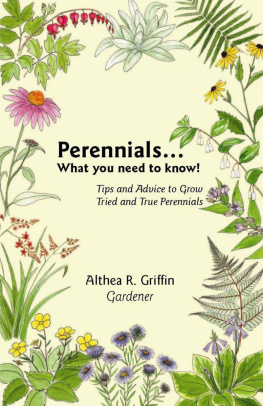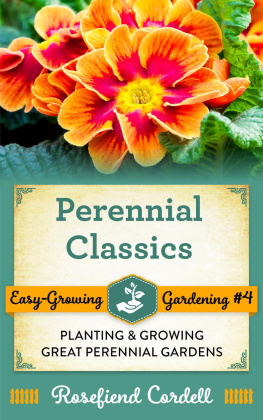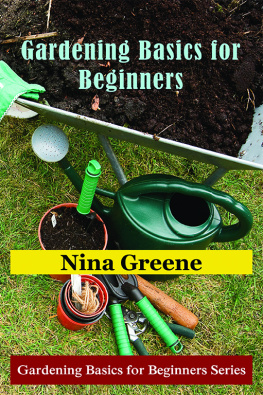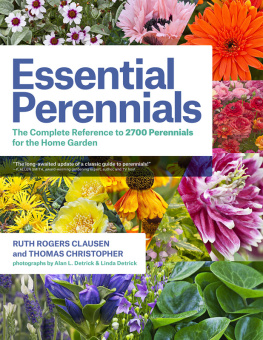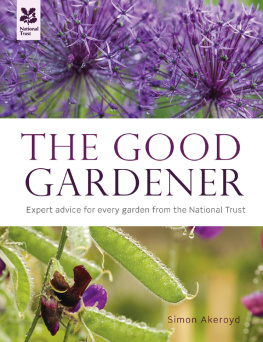
Published by Plant It Publishing, Atlanta, Georgia
Copyright 2011 Althea R. Griffin
All rights reserved. No part of this book may be reproduced or transmitted in any form or by any means, electronic or mechanical, including photocopying, recording or by any information storage and retrieval system, without written permission from the author, except for the inclusion of brief quotations in a review.
ISBN 978-0-9832347-0-8
NOTE: Reference works about perennials do not always agree with regard to botanical nomenclature, and the nomenclature is constantly evolving. Please realize the names of plants, care instructions and results in this book may differ from other gardeners experiences, including information from other reference books, growers, plant societies and authors.
llustrations by Kate Ruland, Dorset, Vermont
Cover and book design by TH Design, Atlanta, Georgia, thdesign.com
Book Coach: Judith Kolberg, Atlanta, Georgia, squallpress.net
Printed in the United States of America on recycled paper.
Dedication
To my parents, Rita and Wesley Ruland, who raised our family of six children in Sunderland, Vermont. All those chores we were given to do, from picking up sticks to planting five hundred pine seedlings to pulling weeds (the only perennial I didnt like in Moms garden), planted the seeds of my love for the outdoors and gardening.
Also thanks to my husband, Scott, for supporting my hours in the garden as well as in my office, our kitchen table, filled with the computer, books and papers while I was writing this book.
The illustrations in this book are all drawn by my sister, Kate Ruland, and are dedicated to our maternal grandmother, Katherine Dahl Marino.

Knockout Rose, Shasta Daisy, Veronica, Lambs Ear, Phlox Sun

Contents

Welcome
Look out your window and there it is a perennial garden full of blossoms, buds and greenery. Daisies, iris, ferns, hostas, roses and more; from spring through fall, color and scent to enjoy along with many choices to cut for bouquets.
You have always wanted a perennial garden, but where do you start? This book is written just for you!
Whether you are new to gardening or have a perennial bed that you would like to improvewhether you are busy 24/7 or have time to sparewhether your garden is in containers on a patio or in your back yardI would like to share over 30 years of experience as a gardener to help you have the perennial garden you have always dreamed of.
This book is full of practical, no-nonsense advice and tips on favorite perennials grown in my gardens. It is an easy-to-read, illustrated guide to reliable choices for both the sun and the shade.
Gardening is a labor of love; it is a joy to the heart and the soul.
Gardening builds friendships; gardeners love to share plants and experience.
Gardening is good for the mind and the body; it relieves stress, burns calories and strengthens your body.
Please enjoy this book as you choose your plants, get your hands in the dirt and grow
Happy Gardening!
What is a Perennial?
Plants that have a lifespan of more than 2 years.
Perennials are permanent, persistant and returning.
What is an Annual?
Plants that grow and flower in a single season.
Annuals are planted once a year.

Crocosmia, Yarrow, Lambs Ear Sun to Part Shade
Garden Design and Planning
As you start exploring the pages of my favorite perennials, here are some basic design concepts to consider for your garden.
Site selection
Match the garden to the size of your yard or property, as well as your amount of leisure time.
Choose a space to showcase and view the perennials from the inside of your home as well as the outside areas.
Styles of Gardens
There are many ways to use perennials in a garden design. The preferred style is all a matter of taste.
Formal: usually involves a structure such as a wall, fence or walkway. Balanced and symmetrical with a repetition of size, color and shape. Good proportion and scale according to the house and yard. Accessories are classic stone urns, cement birdbaths, wrought iron gates to name a few. Colonial Gardens are this style.
Informal: relaxed and asymmetrically balanced. Loose and colorful, with different textures. Garden art here and there. (Just be careful not to overpower the perennials, which should be the stars of the show!) Cottage Gardens are informal.
It is your garden dont worry elements of formal and informal look wonderful together.
Types of Gardens
Choose a garden shape to complement the lawn, any structures, trees and most important, the contours and size of the available land.
Bed: an area of soil prepared for planting.
Island Bed: normally a free-standing, free-form bed of perennials mixed with shrubs under tall trees for a natural setting in an expanse of lawn. A rule of thumb is to place the tallest plants in the center, with the lower growers progressively working out toward the edges.
Mixed Border/Bed: a mixture of perennials, annuals, shrubs and small trees, whether deciduous or evergreen. Always include flowering shrubs, such as hydrangeas and azaleas, to have interesting year-round combinations. This is my favorite way to design a casual appearance, an outcome that was not premeditated or fret over!
Perennial Bed: any size garden planted at the edge of the lawn, along a patio or building. Normally filled with a collection of perennials meant to be viewed close-up, therefore should contain plants that keep a neater appearance year-round.
Perennial Border: normally longer than beds, bordering a building, walkway, fence, etc. Usually thought of as the typical English garden, a space to create a lovely and time-consuming garden.
Design
Choose plants with each season in mind or simply, your favorites. Start with perennials with long blooming periods for the most success and enjoyment. The larger the gardens become, the more extensive the wish list of plants will become.
Mix and match the foliage, especially for shady spots. Make sure the texture and color of the leaves and stems is worth viewing all season long.
Use a single plant, known as a specimen, as a punctuation in the garden where a pop of color, texture or attention is needed.
Color Design
Color is the largest component of any perennial garden thats usually why we garden!
Choice and combinations of colors are limited only by our imaginations use nature as the guide. It does not always follow the rule books.
Ideas for successful use of color:
Monochromatic:
Next page
